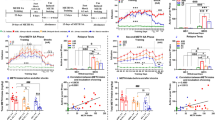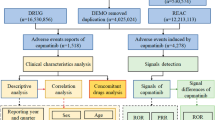Abstract
Bath salts use is associated with high rates of abuse, toxicity, and death. Bath salt preparations often contain mixtures of drugs including multiple synthetic cathinones (eg, 3,4-methylenedioxypyrovalerone (MDPV) or 3,4-methylenedioxymethcathinone (methylone)) or synthetic cathinones and caffeine; however, little is known about whether interactions among bath salt constituents contribute to the abuse-related effects of bath salts preparations. This study used male Sprague–Dawley rats responding under a progressive ratio schedule to quantify the reinforcing effectiveness of MDPV, methylone, and caffeine, administered alone and as binary mixtures (n=12 per mixture). Each mixture was evaluated at four ratios (10 : 1, 3 : 1, 1 : 1, and 1 : 3) relative to the mean ED50 for each drug alone. Dose-addition analyses were used to determine the predicted, additive effect for each dose pair within each drug mixture. MDPV, methylone, and caffeine maintained responding in a dose-dependent manner, with MDPV being the most potent and effective, and caffeine being the least potent and effective of the three bath salts constituents. High levels of responding were also maintained by each of the bath salts mixtures. Although the nature of the interactions tended toward additivity for most bath salts mixtures, supra-additive (3 : 1 MDPV : caffeine, and 3 : 1 and 1 : 1 methylone : caffeine) and sub-additive (3 : 1, 1 : 1, and 1 : 3 MDPV : methylone) interactions were also observed. Together, these findings demonstrate that the composition of bath salts preparations can have an impact on both their reinforcing potency and effectiveness, and suggest that such interactions among constituent drugs could contribute to the patterns of use and effects reported by human bath salts users.
Similar content being viewed by others
Log in or create a free account to read this content
Gain free access to this article, as well as selected content from this journal and more on nature.com
or
References
Aarde SM, Huang PK, Creehan KM, Dickerson TJ, Taffe MA (2013). The novel recreational drug 3,4-methylenedioxypyrovalerone (MDPV) is a potent psychomotor stimulant: self-administration and locomotor activity in rats. Neuropharmacology 71: 130–140.
Atkinson J, Enslen M (1976). Self-administration of caffeine by the rat. Arzneimittelforschung 26: 2059–2061.
Baumann MH, Partilla JS, Lehner KR, Thorndike EB, Hoffman AF, Holy M et al (2013). Powerful cocaine-like actions of 3,4-methylenedioxypyrovalerone (MDPV), a principal constituent of psychoactive bath salts products. Neuropsychopharmacology 38: 552–562.
Brandt SD, Sumnall HR, Measham F, Cole J (2010). Analyses of second-generation ‘legal highs’ in the UK: Initial findings. Drug Test Anal 2: 377–382.
Briscoe RJ, Vanecek SA, Vallett M, Baird TJ, Holloway FA, Gauvin DV (1998). Reinforcing effects of caffeine, ephedrine, and their binary combination in rats. Pharmacol Biochem Behav 60: 685–693.
Cameron KN, Kolanos R, Solis E Jr, Glennon RA, De Felice LJ (2013). Bath salts components mephedrone and methylenedioxypyrovalerone (MDPV) act synergistically at the human dopamine transporter. Br J Pharmacol 168: 1750–1757.
Caudevilla-Gálligo F, Ventura M, Iciar BI, Ruiz I, Fornís I (2013). Presence and composition of cathinone derivatives in drug samples taken from a Drug Test Service in Spain (2010–2012). Hum Psychopharmacol 28: 341–344.
Collins RJ, Weeks JR, Cooper MM, Good PI, Russell RR (1984). Prediction of abuse liability of drugs using IV self-administration by rats. Psychopharmacology 82: 6–13.
Collins GT, Abbott M, Galindo K, Rush EL, Rice KC, France CP (2016). Discriminative stimulus effects of binary drug mixtures: studies with cocaine, MDPV, and caffeine. J Pharmacol Exp Ther 359: 1–10.
Comer SD, Carroll ME (1996). Oral caffeine pretreatment produced modest increases in smoked cocaine self-administration in rhesus monkeys. Psychopharmacology 126: 281–285.
Creehan KM, Vandewater SA, Taffe MA (2015). Intravenous self-administration of mephedrone, methylone, and MDMA in female rats. Neuropharmacology 92: 90–97.
Davies S, Wood DM, Smith G, Button J, Ramsey J, Archer R et al (2010). Purchasing “legal highs” on the Internet—is there consistency in what you get? Q J Med 103: 489–493.
Elmore JS, Dillon-Carter O, Partilla JS, Ellefsen KN, Concheiro M, Suzuki M et al (2017). Pharmacokinetic profiles and pharmacodynamics effects for methylone and its metabolites in rats. Neuropsychopharmacology 42: 649–660.
Eshleman AJ, Wolfrum KM, Hatfield MG, Johnson RA, Murphy KV, Janowsky A (2013). Substituted methcathinones differ in transporter and receptor interactions. Biochem Pharmacol 85: 1803–1815..
Ferré S (2016). Mechanisms of the psychostimulant effects of caffeine: implications for substance use disorders. Psychopharmacology 233: 1963–1973.
Forrester MB (2012). Synthetic cathinone exposures reported to Texas poison centers. Am J Drug Alcohol Abuse 38: 609–615.
Gannon BM, Galindo KI, Rice KC, Collins GT (2017a). Individual differences in the relative reinforcing effects of 3,4-methylenedioxypyrovalerone (MDPV) under fixed and progressive ratio schedules of reinforcement in rats. J Pharmacol Exp Ther 361: 181–189.
Gannon BM, Rice KC, Collins GT (2017b). Reinforcing effects of 3,4-methylenedioxypyrovalerone (MDPV), α-pyrrolidinopentiophenone (α-PVP) and their enantiomers in rats. Behav Pharmacol (e-pub ahead of print 31 May 2017; doi:10.1097/FBP.0000000000000315).
Garrett BE, Griffiths RR (2001). Intravenous nicotine and caffeine: subjective and physiological effects in cocaine abusers. J Pharmacol Exp Ther 296: 486–494.
Goh CY, van Bronswijk W, Priddis C (2008). Rapid nondestructive on-site screening of methylamphetamine seizures by attenuated total reflection fourier transform infrared spectroscopy. Appl Spectrosc 62: 640–648.
Horger BA, Wellman PJ, Morien A, Davies BT, Schenk S (1991). Caffeine exposure sensitizes rats to the reinforcing effects of cocaine. Neuroreport 2: 53–56.
Johnson PS, Johnson MW (2014). Investigation of "bath salts" use patterns within an online sample of users in the United States. J Psychoactive Drugs 46: 369–378.
Justinova Z, Ferré S, Barnes C, Wertheim CE, Pappas LA, Goldberg SR et al (2009). Effects of chronic caffeine exposure on adenosinergic modulation of the discriminative-stimulus effects of nicotine, methamphetamine, and cocaine in rats. Psychopharmacology 203: 355–367.
Justinova Z, Ferré S, Segal PN, Antoniou K, Solinas M, Pappas LA et al (2003). Involvement of adenosine A1 and A2A receptors in the adenosinergic modulation of the discriminative-stimulus effects of cocaine and methamphetamine in rats. J Pharmacol Exp Ther 307: 977–986.
Lapachinske SF, Okai GG, dos Santos A, de Bairros AV, Yonamine M (2015). Analysis of cocaine and its adulterants in drugs for international trafficking seized by the Brazilian Federal Police. Forensic Sci Int 247: 28–53.
National Research Council (2011) Guide for the Care and Use of Laboratory Animals 8th edn National Academy Press: Washington, DC, USA.
Nguyen JD, Grant Y, Creehan KM, Vandewater SA, Taffe MA (2016). Escalation of intravenous self-administration of methylone and mephedrone under extended access conditions. Addict Biol (e-pub ahead of print 5 April 2016; doi:10.1111/adb.12398).
Pearson JM, Hargraves TL, Hair LR, Massucci CJ, Frazee CC III, Garg U et al (2012). Three fatal intoxications due to methylone. J Anal Toxicol 36: 444–451.
Pederson AJ, Petersen TH, Linnet K (2013). In vitro metabolism and pharmacokinetic studies on methylone. Drug Metab Dispos 41: 1247–1255.
Ross EA, Watson M, Goldberger B (2011). “Bath salts” intoxication. N Engl J Med 365: 967–968.
Schenk S, Valadez A, Horger BA, Snow S, Wellman PJ (1994). Interactions between caffeine and cocaine in tests of self-administration. Behav Pharmacol 5: 153–158.
Schindler CW, Thorndike EB, Goldberg SR, Lehner KR, Cozzi NV, Brandt SD et al (2016). Reinforcing and neurochemical effects of the “bath salts” constituents 3,4-methylenedioxypyrovalerone (MDPV) and 3,4-methylenedioxy-N-methylcathinone (methylone) in male rats. Psychopharmacology 233: 1981–1990.
Seely KA, Patton AL, Moran CL, Womack ML, Prather PL, Fantegrossi WE et al (2013). Forensic investigation of K2, Spice, and “bath salt” commercial preparations: a three-year study of new designer drug products containing synthetic cannabinoid, stimulant, and hallucinogenic compounds. Forensic Sci Int 233: 416–422.
Shanks KG, Dahn T, Behonick G, Terrell A (2012). Analysis of first and second generation legal highs for synthetic cannabinoids and synthetic stimulants by ultra-performance liquid chromatography and time of flight mass spectrometry. J Anal Toxicol 36: 360–371.
Simmler LD, Buser TA, Donzelli M, Schramm Y, Dieu L-H, Huwyler J et al (2013). Pharmacological characterization of designer cathinones in vitro. Br J Pharmacol 168: 458–470.
Spiller HA, Ryan ML, Weston RG, Jansen J (2011). Clinical experience with and analytical confirmation of bath salts and “legal highs” (synthetic cathinones) in the United States. Clin Toxicol 49: 499–505.
Substance Abuse and Mental Health Services Administration. Drug Abuse Warning Network, 2011: National Estimates of Drug-Related Emergency Department Visits. HHS Publication No. (SMA) 13-4760, DAWN Series D-39. Substance Abuse and Mental Health Services Administration: Rockville, MD, 2013..
Tallarida RJ, Raffa RB (2010). The application of drug dose equivalence in the quantitative analysis of receptor occupation and drug combinations. Pharmacol Ther 127: 165–174.
Vandewater SA, Creehan KM, Taffe MA (2015). Intravenous self-administration of entactogen-class stimulants in male rats. Neuropharmacology 99: 538–545.
Vidal Giné C, Ventura Vilamala M, Fornís Espinosa I, Gil Lladanosa C, Calzada Álvarez N, Fitó Fruitós A et al (2016). Crystals and tablets in the Spanish ecstasy market 2000-2014: are they the same or different in terms of purity and adulteration? Forensic Sci Int 263: 164–168.
Watterson LR, Hood L, Sewalia K, Tomek SE, Yahn S, Johnson CT et al (2013). The reinforcing and rewarding effects of methylone, a synthetic cathinone commonly found in “bath salts”. J Addict Res Ther Supp 9: 002. doi:10.4172/2155-6105.S9-002.
Watterson LR, Kufahl PR, Nemirovsky NE, Sewalia K, Grabenauer M, Thomas BF et al (2014). Potent rewarding and reinforcing effects of the synthetic cathinone 3,4-methylenedioxypyrovalerone (MDPV). Addict Biol 19: 165–174.
Wee S, Anderson KG, Baumann MH, Rothman RB, Blough BE, Woolverton WL (2005). Relationship between the serotonergic activity and reinforcing effects of a series of amphetamine analogs. J Pharmacol Exp Ther 313: 848–854.
Wee S, Woolverton WL (2006). Self-administration of mixtures of fenfluramine and amphetamine by rhesus monkeys. Pharmacol Biochem Behav 84: 337–343.
Zuba D, Byrska B (2013). Prevalence and co-existance of active components of “legal highs”. Drug Test Anal 5: 420–429.
Author information
Authors and Affiliations
Corresponding author
Additional information
Supplementary Information accompanies the paper on the Neuropsychopharmacology website
Supplementary information
Rights and permissions
About this article
Cite this article
Gannon, B., Galindo, K., Mesmin, M. et al. Reinforcing Effects of Binary Mixtures of Common Bath Salt Constituents: Studies with 3,4-Methylenedioxypyrovalerone (MDPV), 3,4-Methylenedioxymethcathinone (methylone), and Caffeine in Rats. Neuropsychopharmacol. 43, 761–769 (2018). https://doi.org/10.1038/npp.2017.141
Received:
Revised:
Accepted:
Published:
Issue date:
DOI: https://doi.org/10.1038/npp.2017.141
This article is cited by
-
Relative reinforcing effects of dibutylone, ethylone, and N-ethylpentylone: self-administration and behavioral economics analysis in rats
Psychopharmacology (2022)
-
MDPV “high-responder” rats also self-administer more oxycodone than their “low-responder” counterparts under a fixed ratio schedule of reinforcement
Psychopharmacology (2021)
-
Effects of cocaine on the discriminative stimulus and reinforcing effects of mephedrone in male rats
Psychopharmacology (2019)
-
Self-administration of the synthetic cathinones 3,4-methylenedioxypyrovalerone (MDPV) and α-pyrrolidinopentiophenone (α-PVP) in rhesus monkeys
Psychopharmacology (2019)
-
Behavioral economic analysis of the reinforcing effects of “bath salts” mixtures: studies with MDPV, methylone, and caffeine in male Sprague-Dawley rats
Psychopharmacology (2019)



